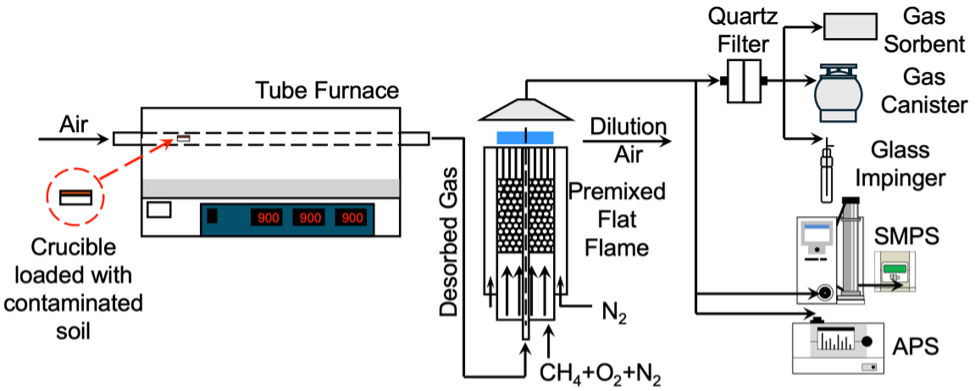Quantifying the Emission and Health Impacts of Aerosols Generated from Southeast U.S. Wetland Biomass Burning
Wildland fires create risks to public health, environment, and economy. The Southeast U.S. wetlands have a high fire frequency and intensity due to the excessive growth of wetland biomass, but the emissions and impacts of these fires are not fully understood. This project will use controlled laboratory experiments to study wetland biomass burning emissions. The project will examine the physical and chemical properties of particulate matter (aerosols) generated directly from biomass burning combustion, as well as those generated from the photochemical aging of the burning smoke. Toxicity measurements will further examine the health effects of wetland biomass burning aerosols. The results from this project will assist the management of wetland fires and improve predictions of their impact on air quality, environment, and public health. The project will also include new educational activities and museum demonstrations to help students and society better understand and manage wildland fires.

Early stages of particle formation in high temperature aerosol reactors
Aerosol science and technology enable continual advances in material synthesis and atmospheric pollutant control. Among these advances, one important frontier is characterizing the initial stages of particle formation by real time measurement of particles below 2 nm in size. Sub 2 nm particles play important roles by acting as seeds for particle growth, ultimately determining the final properties of the generated particles. Tailoring nanoparticle properties requires a thorough understanding and precise control of the particle formation processes, which in turn requires characterizing nanoparticle formation from the initial stages. The knowledge on particle formation in early stages can also be applied in quantum dot synthesis and material doping. This project pursued two approaches in investigating incipient particle characterization in systems with aerosol formation and growth: (1) using a high-resolution differential mobility analyzer (DMA) to measure the size distributions of sub 2 nm particles generated from high-temperature aerosol reactors, and (2) analyzing the physical and chemical pathways of aerosol formation during combustion.

Thermal remediation: unraveling the fate of per- and polyfluoroalkyl substances (PFAS) in contaminated soil during lab-scale incineration processes
Per- and Polyfluoroalkyl Substances (PFAS) are a large group of chemicals used in numerous industrial and consumer applications, and they have recently been identified as a major human health threat. Over 100 PFAS-contaminated sites have been identified in Florida, and many contaminated locations, such as firefighting training sites, military installations, and dry cleaners, are expected to require soil remediation. Traditional soil remediation technologies are ineffective for PFAS treatment; however, preliminary research into high-temperature thermal treatment has shown promise. In collaboration with the University of Florida, we aim to develop a mechanistic understanding of the (a) desorption and decomposition of PFAS from contaminated soil and (b) their destruction pathways utilizing lab-scale thermal treatment processes. The physicochemical properties of the particulate and gaseous components generated from the incineration processes will be obtained from controlled experiments performed in furnace and flame reactors. This data can then be used to design robust thermal treatment processes for deployment of effective and safe PFAS destruction methodology in large-scale soil remediation systems.

Quantifying and Minimizing the Environmental Impact of Agricultural Plastic Mulch Film Burning
Agricultural plastic mulch film, a widely used plastic material for soil coverage to enhance crop yields, presents increasing issues in its waste management, where current disposal methods are insufficient to address these challenges. The open burning of plastic mulch film, currently allowed in the State of Florida, could release harmful pollutants, posing risks to the environment and human health. This project aims to quantify and minimize the environmental impact of plastic mulch film burning through a series of controlled laboratory burning experiments. Samples of field-collected used plastic mulch film with entrained soils will be burned in a tube furnace reactor and an open burning reactor, and the emitted air and soil pollutants will be characterized by a set of online and offline instruments at the University of Miami and the University of Florida. By simulating real-world burning conditions, the project will provide the properties and emission factors of environmental pollutants and compare them against current federal and state regulations. We will further identify combustion conditions (including burning temperature, burning duration, and method of burning) that could reduce the pollutant emission and minimize the environmental and potential health impacts. The findings will inform stakeholders about the environmental risks of open burning and provide evidence-based recommendations for agricultural plastic management practices. This research will contribute to better regulatory compliance, fostering economical agricultural practices, and addressing gaps in agricultural plastics management.

Conference presentations:
Titanium Dioxide and Silicon Dioxide Formation in Corona Discharge Assisted Combustion (2024)
Funded projects:
CAREER: Quantifying the Emission and Health Impacts of Aerosols Generated from Southeast U.S. Wetland Biomass Burning (NSF: 2025-2030)
Conference: Center for Aerosol Science and Technology (CAST) Workshop on Wildland Fire Emissions and Indoor Air Quality (NSF: 2025-2026)
Ultrafine Inorganic Particle Formation in Plasma-Assisted Combustion (NSF: 2021-2025)
Thermal remediation: unraveling the fate of per- and polyfluoroalkyl substances (PFAS) in contaminated soil during lab-scale incineration processes (Florida Department of Environmental Protection: 2024 to 2025)







